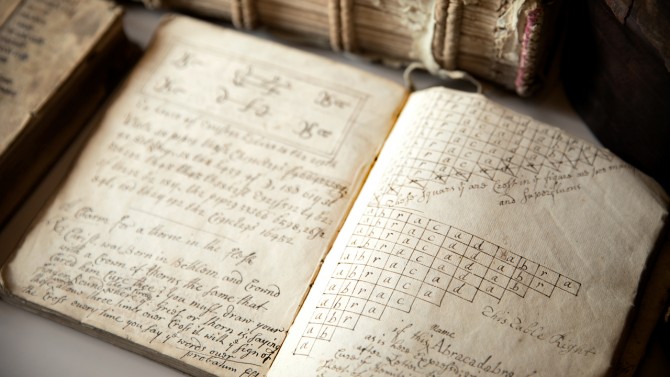
Books on witchcraft from the 15th and 16th centuries housed in the Division of Rare and Manuscript Collections.
Cornell Witchcraft Collection exhibition opens on Halloween
By Melanie Lefkowitz
A new library exhibition offers a rare glimpse of the Cornell Witchcraft Collection, featuring some of the earliest known writings on witches as well as 21st-century witchcraft movie posters to illustrate how popular views on witches have evolved over 500 years.
“The World Bewitch’d” explores the origins and spread of the belief in witchcraft, as well as the persecution of tens of thousands of supposed witches across Europe, through documents and manuscripts from the Cornell Witchcraft Collection – originally part of Cornell co-founder Andrew Dickson White’s personal library and now the largest of its kind in North America.
The opening reception, which is free and open to the public, will take place Oct. 31 from 4 to 5:30 p.m. on Level 2B, Kroch Library.
The rare artifacts on display in the exhibition, in the library’s Division of Rare and Manuscript Collections, will include handwritten transcripts from European witch trials, the first book on witchcraft ever printed, the first printed image of witches in flight, centuries-old religious texts, and collections of spells and “prescriptions” for curing illnesses, lessening the pain of childbirth and more.
“A.D. White was always collecting things that made us think, whether they were anti-slavery documents or they focused on people on the margins,” said Anne R. Kenney, the former Carl A. Kroch University Librarian, who is co-curating the exhibition. “This collection has profound repercussions in today’s world, where the persecution of the defenseless is alive and well.”
Accounts of supposed instances of witchcraft, definitions of witchcraft, witness statements and means of extracting confessions also shed light on “the potential violence in the madness of crowds,” Kenney said.
“People can be led to think all sorts of weird stuff,” she said. “These women were condemned to death for flying at night and shape-shifting into animal forms.”
Gender is among the themes of the exhibition, which highlights depictions of witches as ugly old crones or alluring women. In the 15th and 16th centuries, some theologians believed women were susceptible to witchcraft because their supposedly lesser intelligence allowed them to be manipulated by the devil, while others thought women were lured by witchcraft because of their sexuality.
The witchcraft movie posters – a relatively recent addition to the collection – show how witchcraft has been politicized around the world, as well as how witches have been “domesticated” in popular culture.
“Because witches are so powerful and threatening, sometimes they are put in the real world to see what the comical outcomes are. They marry men and have to hide their magic, or they wreak havoc that has to be cleaned up,” said exhibit co-curator Kornelia Tancheva, formerly associate university librarian for research and learning services at Cornell and now director of the University of Pittsburgh library system. “The audience loves them, and they allow for a release of tension.”
“The World Bewitch’d” will be on display in Kroch Library’s Hirshland Gallery through Aug. 31, 2018.
Melanie Lefkowitz is staff writer, editor and social media coordinator for Cornell University Library.
Media Contact
Get Cornell news delivered right to your inbox.
Subscribe